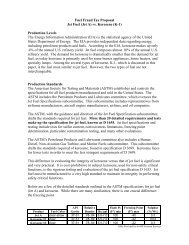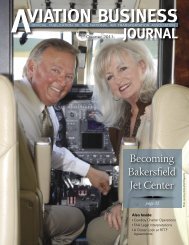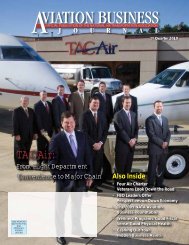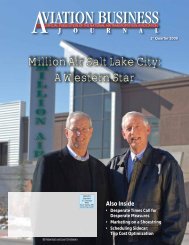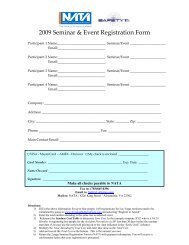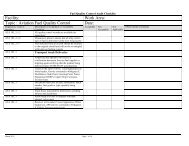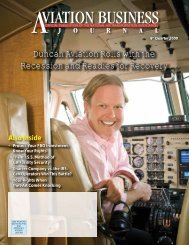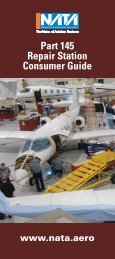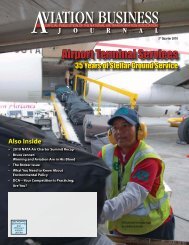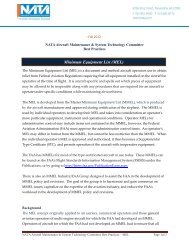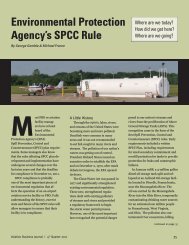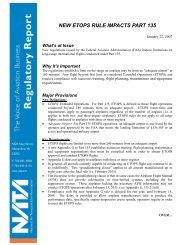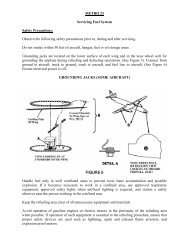Computer-Based Maintenance Tracking Flight Training ... - NATA
Computer-Based Maintenance Tracking Flight Training ... - NATA
Computer-Based Maintenance Tracking Flight Training ... - NATA
- No tags were found...
Create successful ePaper yourself
Turn your PDF publications into a flip-book with our unique Google optimized e-Paper software.
as APUs for Affluent Personal Users.“These were all of my business and professionalfriends who use aircraft or rent aircraft for serioususe. These are not casual users,” Lotz said. “I said,‘This is going to be my market. This is who I am goingto cater to.’”Once he had defined his base customer, Lotz setabout developing a curriculum that met the FAA<strong>Flight</strong> <strong>Training</strong> Standards and the needs of thisunique market segment.“I asked myself what kind of environment do thesecustomers like and deserve, and what kind of equipmentand practices should we engage in,” he said.“That differentiated me from the get-go in terms ofhow most operations set up their businesses.”Lotz scrapped the equipment used by the previousowners. He purchased new Cessna 172s andmade sure his instructors were the most qualifiedpilots around. As Lotz set about improving the quality,he also raised the rates he charged for instruction.Lotz joined the Cessna Pilot Center program as ameans to provide structural support for his business.“Cessna had the infrastructure in place to allowus to provide greater utility, greater efficiency,and thus greater value to our customers,” he said.“If on one hand I am going to charge aggressivelyfor above average services, equipment, and personnel,on the other hand I take very seriously theneed to reduce the costs in total as much as I cananywhere in my operation,” he said. “So the CessnaPilot Center, through a structured, well thought out,well designed program, enabled us to get studentsthrough the private license in 55 hours on averagenationally, when the AOPA [Aircraft Owners andPilots Association] was saying the average acrossthe United States for all operators to get the privatepilot license was 80.1 hours. It also gave me astructure that allowed me to try to beat the 55-houraverage.”Putting Technology to WorkTo minimize flight hours while not sacrificingtraining, Lotz introduced flight training devices(FTDs) into his training curriculum. In this way hecould operate similarly to FAA Part 141 Pilot Schooloperations while still offering Part 61 Private PilotInstructor training. By introducing this emergingtechnology, Lotz realized his other goal of producingsafer and better pilots.According to Victor Veltze of Frasca International,an FTD is a training device that consists of a set ofpilot controls identical to an aircraft and a screenUsing simulators and FTDsallows students to learn difficultmaneuvers and principleson the ground at a muchlower operating cost and thendemonstrate them in theairplane.that replicates the aircraft’s movement in responseto the pilot’s manipulation of the controls withoutsimulating the actual movement of the aircraft. Asimulator, on the other hand, usually has a widerscreen, which wraps around the cockpit and integratesa series of computer-controlled servos andpistons to cause the cockpit to actually move inresponse to the pilot’s actions.Both Lotz and Veltze said they have met resistancefrom some Certified <strong>Flight</strong> Instructors (CFIs)in using simulators but feel that the majority of theopposition is self-serving. They said that many CFIsare worried about losing actual flight training hoursby teaching maneuvers in the FTDs and simulators.Lotz saw the benefit of the FTDs long before heimplemented the technology. “This was five or sixyears ago, and the same Cessna 172 flight trainingdevice that Frasca sells now for $220,000 was selling$450,000,” Lotz said. “So we had to wait until thepricing curve got better.”For Monterey Bay Aviation the time was rightabout 18 months ago, and they were able to gettheir FTD program online.This move came at around the same time thatEmbry-Riddle Aeronautical University (ERAU) alsorealized the savings potential of using Level 6 FTDsfor training. Unlike some state-of-the-art flightsimulators, the Level 6 FTD has no motion system,but it does require all cockpit controls to be fullyand realistically functional. According to a report byDr. Tim Brady, dean of ERAU’s College of Aviation,while a Frasca 172 Level 6 FTD costs around threetimes more than a Cessna 172 aircraft, that cost ismore than offset by the savings in operating costsbetween the FTD and the actual airplane.“But the utility of the simulators is four times thatof the airplane,” Brady wrote. “FTDs have muchlower operating cost and are unaffected by dramaticrises in associated aircraft operating costs such asinsurance.”Integrating FTDs at Monterey Bay Aviationinvolved researching studies done by ERAU on successesoperators were having in integrating FTDswith the actual aircraft in Part 142 <strong>Training</strong> Centerprograms. The idea was to base their curriculumContinued on page 36Aviation Business Journal | 3 rd Quarter 200733


